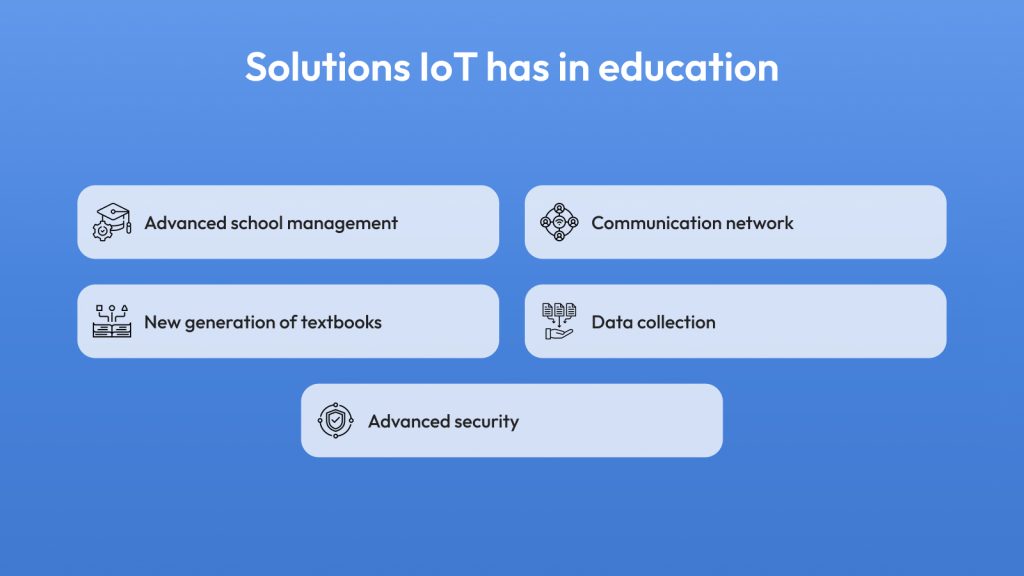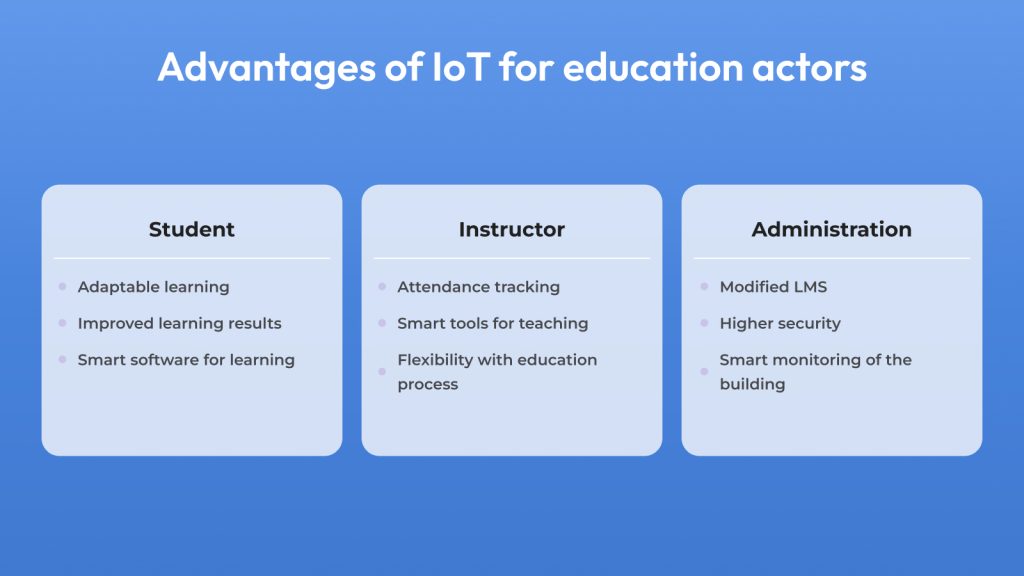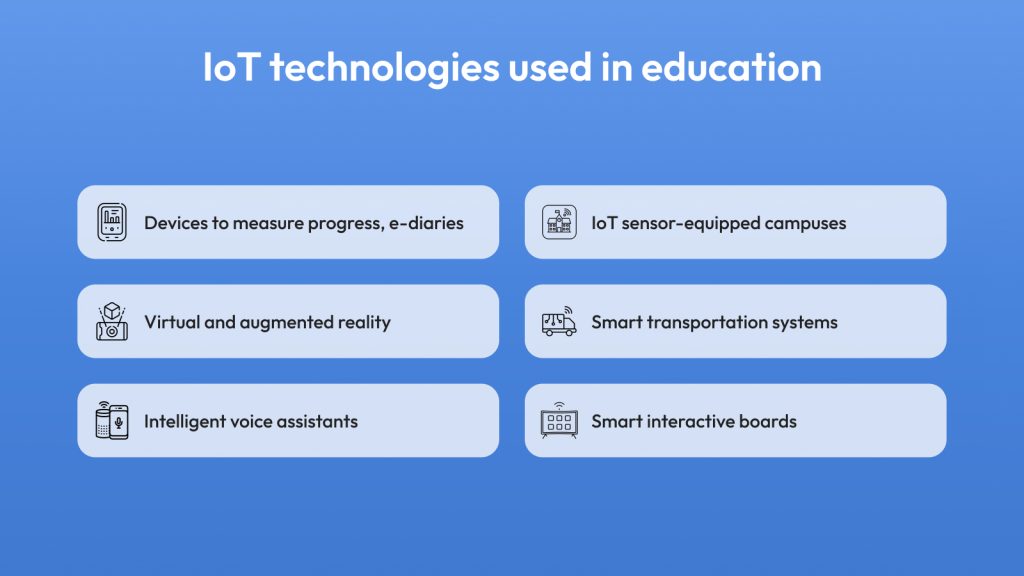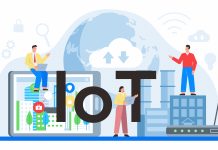Technology has a profound impact on how we approach education, revolutionizing traditional teaching methods and enhancing the learning experience. One of the most innovative technologies schools can employ to tailor and refine the learning process is the Internet of Things (IoT). By adopting IoT solutions, educational institutions can create dynamic environments catering to the diverse needs of both students and teachers.
This discussion will explore IoT in education, highlighting the top innovative solutions changing how we learn. These IoT applications range from immersive smart classrooms to personalized learning experiences, transforming education by promoting collaboration, engagement, and instructional effectiveness. Join us as we delve into the potential of IoT in education and its significant impact on shaping the learning journey.
From Smart Boards to Smart Everything: A Look at IoT Integration in Education
The Internet of Things (IoT) is impacting the education sector by integrating devices and technologies to enhance learning and streamline administrative tasks. It involves connecting various objects to the Internet to create a network of smart gadgets that can communicate easily with each other and with humans. This technology offers opportunities for automation, efficiency, and convenience. IoT is used in various industries for tasks like remote temperature control and real-time monitoring of machinery.

The integration of IoT devices in education has been growing, as educational institutions are incorporating them into their classrooms and curriculums. Various devices such as smartboards, tablets, wearable technology, and student activity monitors are being used in school settings to improve learning experiences through enhanced interactivity and personalized learning for students.
The Internet of Things goes beyond convenience and automation in only the education sphere. Thus, IoT for small business can address complex issues, focusing on safety and sustainability. IoT sensors can monitor the environment, and predict disasters. The data collected allows for informed decisions and proactive actions. IoT technology aims to improve daily life and enhance connectivity and intelligence worldwide.
How IoT is Transforming the Educator’s Role: Benefits of the Technological Integration
The integration of IoT (Internet of Things) presents a range of opportunities for everyone involved in the learning process. Let’s explore how students, teachers, and administrators can use IoT to enhance the teaching and learning experience.

Thus, the students can achieve:
- Personalized learning, tailored to individual needs and learning speeds
- Learning process flexibility. It will be accessible anytime and anywhere
- Engaging learning with immersive content enhancing student involvement
- Enhanced performance with the help of academic outcomes improvement through customized resources and interactivity.
The teachers and educational instructors can benefit from IoT the following way: the technology is able to provide them with state-of-the-art digital tools and resources to elucidate complex concepts effectively and engage students in the learning process. IoT solutions also streamline attendance tracking, empowering instructors to monitor student engagement and participation with greater efficiency.
Moreover, IoT gives innovative assessment tools and techniques to instructors to gauge student comprehension and grasp of course material comprehensively. Finally, they explore novel teaching methodologies and educational technologies, enhancing the overall quality of educational delivery.
The educational establishment administrators may accomplish the following, while using IoT:
- Intelligent monitoring for optimal conditions and resource use.
- Real-time surveillance and alerts for campus safety.
- Simplified customization of educational resources to meet objectives.
The integration of IoT in education offers transformative benefits for all stakeholders involved. Overall, IoT empowers educators to deliver high-quality education while leveraging technology to its fullest potential.
How is IoT Used in Education: Solutions Examples
The use of Internet of Things (IoT) technology in education has been growing rapidly in recent years, transforming the traditional landscape of teaching and learning. IoT devices are being used to enhance classroom experiences, improve student engagement, and streamline administrative processes.

IoT technology can revolutionize the education sector by providing innovative solutions fitting the needs of educational institutions. With the help of IoT, schools can create dynamic, interactive, and personalized learning environments that empower both students and educators on their educational journey.
Iot Education Promising Projects
Innovative initiatives are emerging in the education sector to enhance the learning experience for students and streamline teaching for educators amidst the ever-evolving landscape of IoT. Let’s find out TOP-3 IoT implementations in education.
EdModo. Edmodo, established in 2008, is a platform that offers services for parents, teachers, and students in educational institutions. It facilitates communication, collaboration, and support, enabling teachers to easily share important information on new materials, assessments, and surveys.
The Nymi wristbands use advanced biometric authentication technology to recognize individual users’ unique heartbeats for identity authentication. They are used in educational settings to streamline tasks like attendance tracking, allowing teachers to receive real-time updates on student arrivals via their tablets. This way, they demonstrate the possibilities of IoT in education with their unique identity verification method.
C-Penn provides portable scanners specifically designed for students and instructors. C-Pen scanners use optical character recognition technology to digitize text, providing accessibility and convenience for students and educators in different educational environments. They offer easy text scanning with just one button press, followed by immediate transfer to smartphones or other devices.
The above given initiatives demonstrate the various uses of IoT technology in education, ranging from communication platforms to biometric authentication solutions. Educational institutions can leverage IoT to encourage collaboration, simplify administrative tasks, and provide customized learning experiences, resulting in a more efficient and effective education system.
Challenges of IoT Integration: Lessons Learned
Despite the tremendous potential IoT integration holds for education, it also presents several hurdles that organizations must navigate. Let’s delve into some of these challenges.
Implementing IoT projects involves understanding different technologies and platforms, which can be challenging for organizations. IoT projects require technical expertise in selecting hardware and software, integrating systems, and ensuring data security. Outsourcing IoT development to specialized partners can simplify managing these complexities and improve the chances of successful project implementation.
Internet of Things systems often experience compatibility issues due to the struggle of different devices and software to work together seamlessly. The absence of a one-for-all standard for IoT devices results in interoperability challenges, which complicates the integration process. To overcome these complexities, careful planning and coordination are necessary to ensure smooth interoperability across all platforms.
Integrating IoT into education often requires significant investments in hardware and infrastructure. Devices like beacons, wristbands, and interactive whiteboards come with hefty price tags, making it challenging for educational institutions to allocate sufficient funds. While interest in IoT is growing, financing remains a significant barrier to widespread adoption.
The widespread use of IoT networks presents significant security risks, as each connected device can be exploited by hackers. These networks can be susceptible to cyberattacks without strong security measures, potentially leading to data breaches and system malfunctions. In order to mitigate potential risks, IoT devices should be properly secured with authentication measures and robust firewalls.
While IoT integration offers immense potential for transforming education, organizations must effectively address these challenges to realize its full benefits. By overcoming financial constraints, resolving integration issues, strengthening security measures, and leveraging technical expertise, organizations can successfully integrate IoT into education, paving the way for innovation and enhanced learning experiences.
Conclusion
The integration of IoT into education marks a profound advancement in contemporary learning approaches, offering flexible solutions for students, educators, and administrators alike. While it holds the promise of revolutionizing teaching and learning experiences, it’s crucial to address challenges such as financial limitations, integration complexities, and security risks. The skilled software development company can help you succeed with solving these challenges.
With the help of strategic foresight and technical expertise, the IT specialists will help you unlock the transformative potential of IoT, creating inclusive, engaging, and efficient learning ecosystems for leveraging your educational institution’s performance.
Author’s bio
Yuliya Melnik is a technical writer at Cleveroad, a web and mobile app development company in Ukraine. She is passionate about innovative technologies that make the world a better place and loves creating content that evokes vivid emotions.






